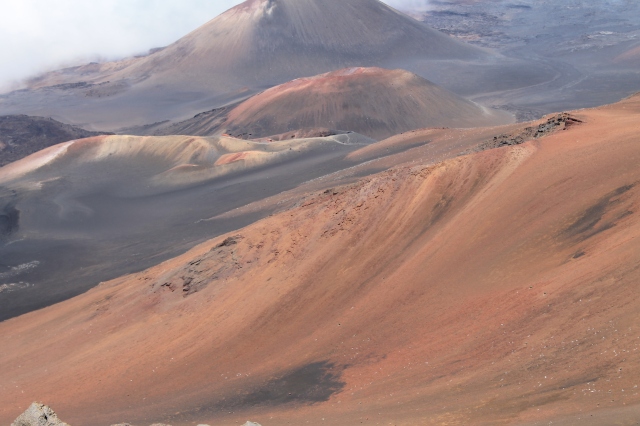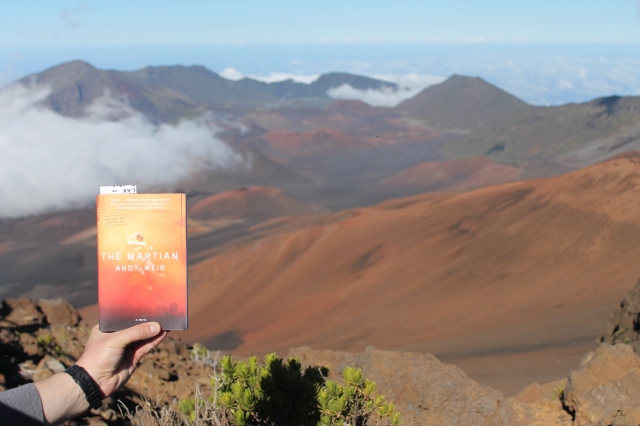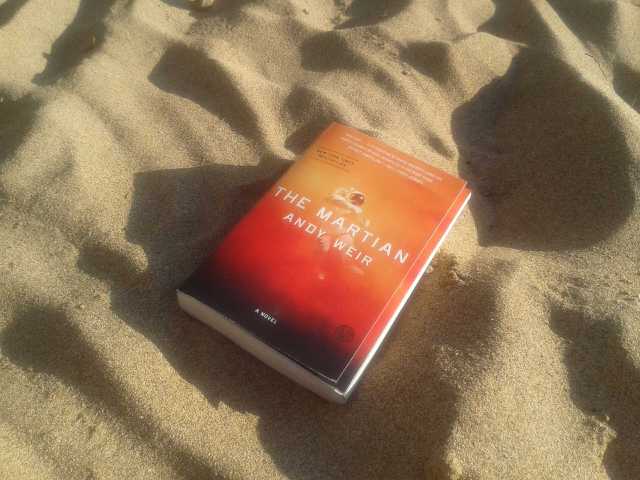I breathed deeply as I looked out at the landscape of Mars.
Okay, so there’s clearly something wrong with that sentence. It’s a pretty good bet that I wouldn’t be breathing deeply if I was standing on Mars – conserving your oxygen supply and all that. Rather, I stood near the top of Haleakala, a crater in Haleakala National Park on the island of Maui in Hawaii.
Haleakala is a volcanic mountain, full of craters from ancient eruptions but likely dormant today. Its sweeping slopes are rocky and covered in a rusty red dust that in more than reminiscent of the Red Planet. Plants grow here and there on the craggy hillsides, but if you stand at just the right angle and zoom in just the right amount, you’ll get nothing but the rusty red hills. You’ll feel like you’re on Mars.

Looks pretty Martian to me….
Well, almost. There’s a few things that suggest you’re not actually on another planet. The oxygen and nitrogen in the air are a helpful clue, even though here at ten thousand feet there’s less of both than usual, and warnings about dizziness and headaches are everywhere. If you look into the distance, you can see the blue of the Pacific Ocean, which reflects the equally blue sky, both definitely belying the idea that it’s a Martian landscape (the sky looks blue on Earth because of the way the atmosphere bends light, and Mars, with its thinner atmosphere, composed of different elements, has a “butterscotch-yellow” sky). And, on this particular day, the rich blue sky is full of fluffy white clouds, while the clouds of Mars, though they exist, are not made of water vapor and are only visible at night, when light reflects off them.
And yet, this was the perfect location for reading a book about surviving on another planet – in this particular case, Andy Weir’s The Martian. This post is my first in a series about “Reading on Location” – that is, reading books in locales that seem perfect for them, or traveling with a book perfectly chosen for the trip. This isn’t the same as literary travel, where you go after you’ve read the book, but rather traveling with a helping of luck and (hopefully) serendipity, where I try to make my books line up with my travels.
And in this particular case, I’ve succeeded: The Martian is the perfect companion for me on the island of Maui.

The Martian, against a backdrop of Haleakala.
In fact, as a Midwesterner, everything about Maui makes me feel a little bit like I’m on a different planet. The palm trees and perpetually sunny days are a change from Michigan, where snow and sleet are out stalwart companions for half the year. When I look up at the stars at night, the constellations have shifted, with the big dipper absolutely in the wrong place (an interesting thought – what do the constellations look like on Mars?) The sun sets early and rises equally at ungodly early hours, and apparently, if you look closely enough at the right moment at the sunset, you’ll see a green flash. And to top it all off, there’s constantly chickens crossing the road, as if this is some kind of crack-fuelled alternate universe where the first lines of jokes literally happen. In the larger scope of things, I may not have travelled that much – I’ve only crossed about half of our little planet – but since we haven’t invented warp drives yet, this is, relatively speaking, the farthest away from all that is familiar that I can actually go. And even having travelled that small distance, there is a disorienting element of foreignness to everything I encounter.
It may not be Mars, but being here does make you think about the larger scope of things. Hawaii is a chain of islands formed from volcanic rock eons ago, and there’s the same sense of inscrutable, age-old natural processes behind it as behind the mysteries of a distant red planet. Being on a tiny, unfamiliar island in the middle of an expanse of ocean, with different flora and fauna and different constellations and a different pattern of the rising and setting of the sun – it makes you think about how our planet is part of something bigger, a mystery and an order of things that exists on a more cosmic scale. Which is a sentiment that science fiction, when done right, is supposed to evoke – and which The Martian certainly does.

The dust of “Mars”
I arrive wearily home with sneakers covered in red dust from hiking up and down Haleakala, which I proudly sport for the rest of my trip. Somewhere in The Martian, the protagonist, Mark Watney, mentions that Mars is red because it’s so old that it’s literally rusting. I’m not sure if that’s the case here, too, though these ancient volcanic islands make me hope that it is. At the end of the day, I sit on the beach and read more of The Martian after going for a swim in the Pacific Ocean. There’s no oceans on Mars (anymore), but there’s certainly plenty of sand and rock and sitting on the sandy beach, covered in sand, with my book plastered in sand (there’s a lot of sand), I let it fall through my fingers and thing about a red planet far away, and how this distant clime on these tiny islands in the middle of the Pacific Ocean can almost feel like a different planet with the right perspective.

